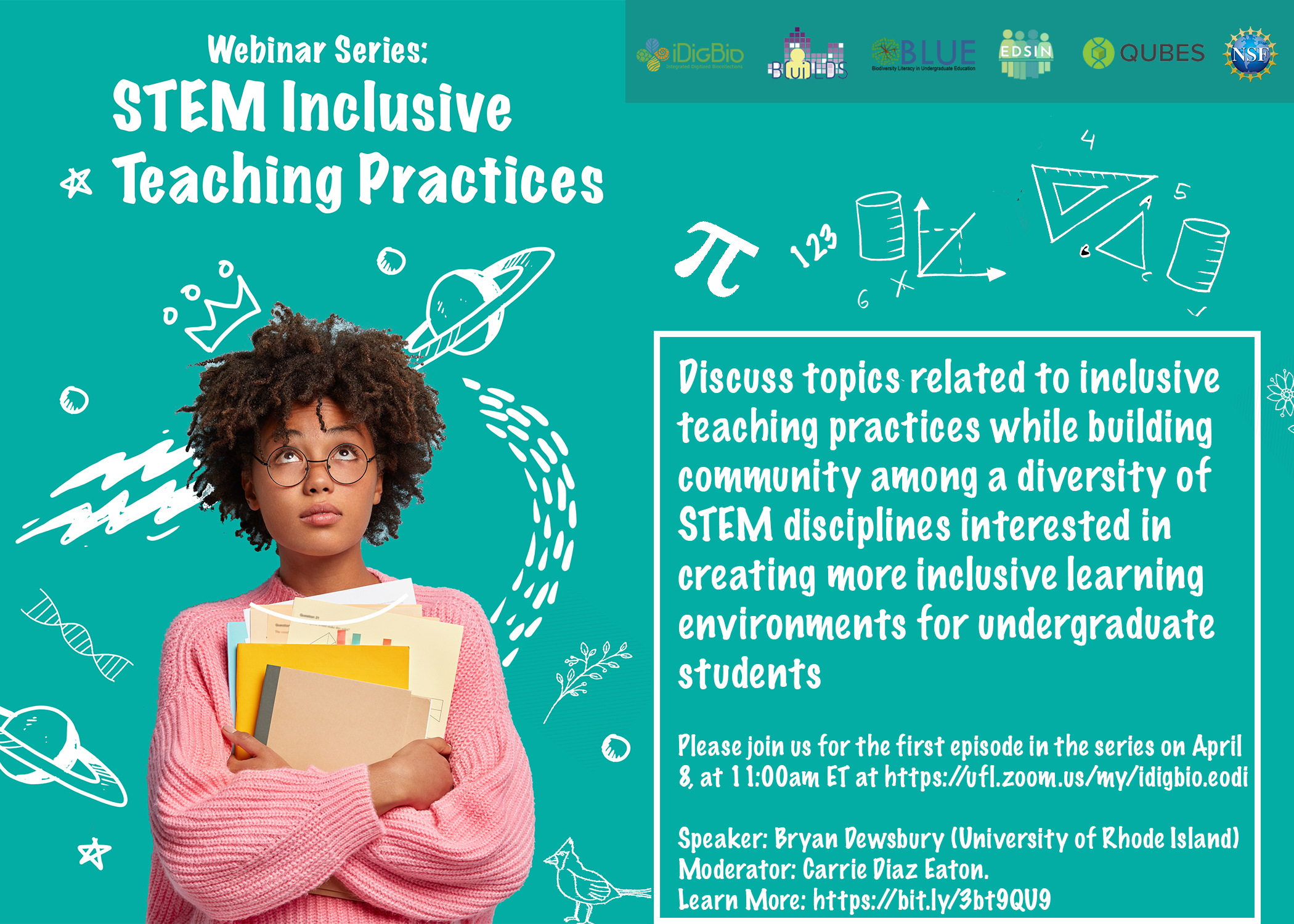
In these mini-Newsletters, we continue to focus on the rapid, nationwide transition to online education, highlighting resources for now, and next steps for collaborations within the new normal.
Teaching Quantitative Biology Online: Resources and Office Hours

Resources for Teaching Quantitative Biology Online is a collection of open education resources (OERs) that are designed to teach quantitative skills in a variety of biological contexts and will work well in an online setting with minimal adaptation. This webpage is a rapid response to the need for our community of educators to move learning online quickly.
Resource Walkthroughs provide a quick video description and teacher discussion on resources available for use. These discussions are led by the content creators or a teacher who has used them often. These videos give viewers a very fast overview so that teachers can understand how to use the online materials quickly in these transition times. See here for more information about walk-throughs. We are adding more all the time, so check back and reach out to Deb Rook (deb.rook "at" bioquest "dot" org) if you would like to produce a video guide to your content.
Teaching Quantitative Biology Online Office Hours provide an opportunity to talk with others in the community who have some experience with teaching online, quantitative biology resources, or other valuable information about teaching. These volunteers have offered their time to facilitate conversations, provide information, and support their colleagues as courses move online for the semester.
See here for links to join and more information about office hours.
If you would like to volunteer to host office hours, please contact Deb Rook (deb.rook "at" bioquest "dot" org).
QUBES partners and individuals can share and highlight modules, as well as indicating adaptations made to existing OERs. Join the group to contribute your own ideas! We expect this resource to grow quickly, so check back often. 
Remote Teaching Tools with SimBio
If you are in need of remote teaching tools due to the COVID-19 pandemic, SimBio is here to help! SimBio’s inquiry-driven virtual labs and interactive chapters cover topics in introductory biology, ecology, evolution, and cell biology, and use built-in tools to make it easy to set up, deliver, and assess student work. If you and your course are new to SimBio, we’re offering free trials of SimBio’s modules this term to help instructors move courses online. (If you are an existing customer and your classes are being impacted by closures, you may add additional modules to your SimUText at no extra charge.) For more information, please visit the coronavirus response page on the SimBio website.
Webinar Information to help instructors get started! Instructors often find SimBio’s 20-30 minute webinars with SimBio authors to be an efficient way to get up and running quickly.
- Webinar #1 Teaching with SimUText Ecology, Thursday April 9th, 10a PT/1p ET
- Webinar #2 Simulated Labs for Intro-Level Courses - Friday April 10th, 11a PT/2p ET
STEM Inclusive Teaching Practices Webinar Series
Join us April 8 at 11:00am ET on iDigBio's Zoom Call.

Join us for the first episode in this webinar series where we will discuss topics related to inclusive teaching practices!
NIMBioS Webinar Series: Costs and benefits of defending against viral infection

NIMBioS is hosting a series of webinars focusing on topics at the interface of mathematics and biology. Learn more about upcoming webinars in the series at NIMBioS
Tuesday, April 7, at 3:30 p.m. Eastern
Online, Free and Open to the Public (but you need to register for the webinar here!)
Title. Costs and benefits of defending against viral infection: Lessons from natural ecosystems
 Abstract. The COVID-19 virus is shaping Earth in unprecedented ways, for example by changing the rate at which humans release greenhouse gasses into the atmosphere. Yet, through their activity in natural ecosystems, viruses have been shaping Earth as a system for millions of years. In this presentation, I will consider diverse ways viruses may have shaped Earth as a system, and discuss the value of mathematical models for understanding factors which govern the dynamics of viral infections globally. Abstract. The COVID-19 virus is shaping Earth in unprecedented ways, for example by changing the rate at which humans release greenhouse gasses into the atmosphere. Yet, through their activity in natural ecosystems, viruses have been shaping Earth as a system for millions of years. In this presentation, I will consider diverse ways viruses may have shaped Earth as a system, and discuss the value of mathematical models for understanding factors which govern the dynamics of viral infections globally.
Dr. David Talmy, Assistant Professor of Microbiology, University of Tennessee, Knoxville.
Conferences Moving to Online! TAGC 2020 and MBMSS 2020
Stay connected while keeping your distance!
TAGC 2020: We are delighted to have found an alternative way for our communities to exchange ideas and share the latest research this April 22-25, 2020. Cross-community thematic sessions will alternate with community-specific sessions dedicated to particular model organisms and disciplines. Register now.
MBMSS 2020: The annual Maine Biological and Medical and Science Symposium (MBMSS) will take place online April 23 and 24, 2020. Registration is open and the abstract submission deadline has been extended to April 5th! Abstracts and posters will be uploaded into various sessions on an online platform, each with an individual discussion forum for questions and answers between participants and presenters. Poster sessions will take place concurrently over the two days of the symposium.
We hope you’ll join us for these exciting experiments!

Writing Studio Short Course: July 21-23 in Minneapolis, MN
In partnership with Society for the Advancement of Biology Education Research (SABER) meeting, CourseSource is hosting a Writing Studio Short Course. We understand that things are difficult right now and travel situations are hard to predict. We will make informed decisions about meeting in person as we get closer to the date. For now, we want to go ahead with the application process so that we can move forward with providing this opportunity, potentially online if needed. Faculty from community colleges, primarily undergraduate institutions, and minority-serving institutions (colleges and universities) are encouraged to apply.
Applications are open and review will begin on April 20, 2020.
Extending Specimens: Curators in the Classroom with BLUE
BLUE (Biodiversity Literacy in Undergraduate Education) is leading Module Development and Implementation Experience for individuals wishing to commit to working in a community of practice, alongside researchers and scientists from the museum community to modify, adapt, and implement a module in the virtual classroom.
If you are interested in developing, implementing, or utilizing the curators expertise and digital biodiversity data in the classroom, see the Curators in the Classroom site:
- Module 1: Form and Function, Diversity, and Dispersal: Natures Flying Machines. March 30 – April 3 (educator); April 6–10 (delivery)
- Module 2: Phenology, Asynchrony, and Climate: Butterfly phenology and Climate Change, April 6–10 (educator); April 13-17 (delivery)
- Module 3: Human evolution/co-evolution: A tale of 3 lice, April 13–17 (educator); April 20–25 (delivery)
Moving a Project to a Collaborative Space? How can QUBESHub help?
Use this 6-question survey to communicate your needs for planning. The QUBESHub Team will respond, helping to support you to take your conference or project online.
Members of the QUBES team are participating in some re-imagined conferences that will be happening through the QUBESHub. Members of the QUBES team are always looking to meet others who have a passion for quantitative biology education. Reach out so we can help you gather your collaborators, move projects forward, and continue to move quantitative biology forward. Connect with us by submitting a support ticket

From left to right: Sam Donovan (Director of OER), Carrie Diaz Eaton (Director of QUBES Consortium), Kristin Jenkins (Director of BioQUEST), Drew LaMar (Director of Cyberinfrastructure), and Jeremy Wojdak (Director of Professional Development).
Do you have a product or result from a QUBES sponsored activity? Help us measure our success by sharing your product or result with QUBES. Learn how to cite QUBES.
|